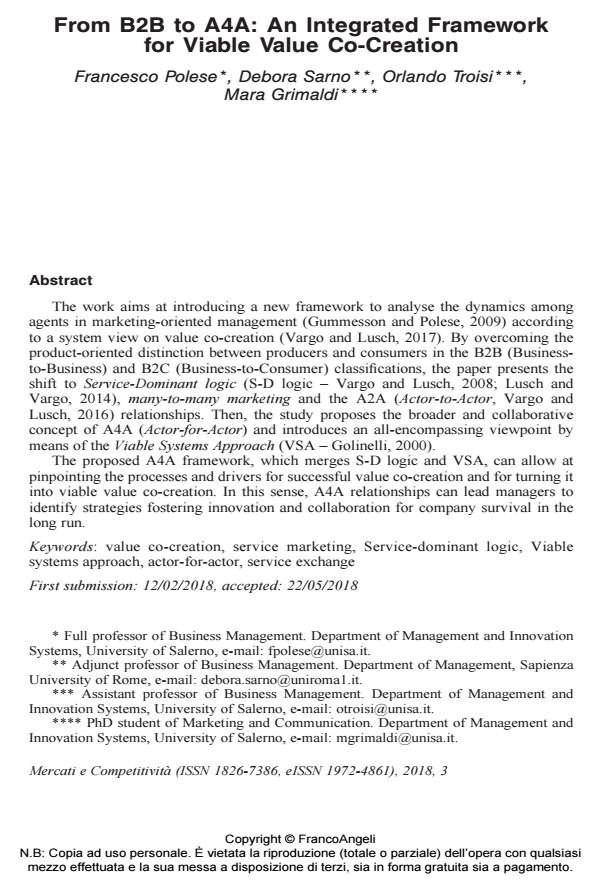From B2B to A4A: An Integrated Framework for Viable Value Co-Creation
Journal title MERCATI & COMPETITIVITÀ
Author/s Francesco Polese, Debora Sarno, Orlando Troisi, Mara Grimaldi
Publishing Year 2018 Issue 2018/3
Language English Pages 27 P. 135-161 File size 163 KB
DOI 10.3280/MC2018-003008
DOI is like a bar code for intellectual property: to have more infomation
click here
Below, you can see the article first page
If you want to buy this article in PDF format, you can do it, following the instructions to buy download credits

FrancoAngeli is member of Publishers International Linking Association, Inc (PILA), a not-for-profit association which run the CrossRef service enabling links to and from online scholarly content.
The work aims at introducing a new framework to analyse the dynamics among agents in marketing-oriented management (Gummesson and Polese, 2009) according to a system view on value co-creation (Vargo and Lusch, 2017). By overcoming the product-oriented distinction between producers and consumers in the B2B (Businessto- Business) and B2C (Business-to-Consumer) classifications, the paper presents the shift to Service-Dominant logic (S-D logic - Vargo and Lusch, 2008; Lusch and Vargo, 2014), many-to-many marketing and the A2A (Actor-to-Actor, Vargo and Lusch, 2016) relationships. Then, the study proposes the broader and collaborative concept of A4A (Actor-for-Actor) and introduces an all-encompassing viewpoint by means of the Viable Systems Approach (VSA - Golinelli, 2000). The proposed A4A framework, which merges S-D logic and VSA, can allow at pinpointing the processes and drivers for successful value co-creation and for turning it into viable value co-creation. In this sense, A4A relationships can lead managers to identify strategies fostering innovation and collaboration for company survival in the long run.
Keywords: Value co-creation, service marketing, Service-dominant logic, Viable systems approach, actor-for-actor, service exchange
- Improving the Evaluation of Scholarly Work Sergio Barile, Francesco Polese, Luca Carrubbo, Francesca Iandolo, pp.45 (ISBN:978-3-031-17661-6)
- Digital Twin Providing New Opportunities for Value Co-Creation through Supporting Decision-Making Shaun West, Oliver Stoll, Jürg Meierhofer, Simon Züst, in Applied Sciences /2021 pp.3750
DOI: 10.3390/app11093750 - Research and Innovation Forum 2022 Andrea Moretta Tartaglione, Ylenia Cavacece, Luca Carrubbo, Antonietta Megaro, pp.675 (ISBN:978-3-031-19559-4)
- Complexity and Emergence in Market Ecosystems Sergio Barile, Francesca Iandolo, pp.211 (ISBN:978-3-031-81941-4)
- The well-being outcomes of multi-actor inter-organisational value co-creation and co-destruction within a service ecosystem Xin Ming Stephanie Chen, Lisa Schuster, Edwina Luck, in Journal of Services Marketing /2023 pp.606
DOI: 10.1108/JSM-03-2022-0082 - Value co-creation ‘gradients’: enabling human-machine interactions through AI-based DSS Luca Carrubbo, Francesco Polese, Monica Drăgoicea, Leonard Walletzký, Antonietta Megaro, T. Le Dinh, M. Drăgoicea, in ITM Web of Conferences /2022 pp.01002
DOI: 10.1051/itmconf/20224101002
Francesco Polese, Debora Sarno, Orlando Troisi, Mara Grimaldi, From B2B to A4A: An Integrated Framework for Viable Value Co-Creation in "MERCATI & COMPETITIVITÀ" 3/2018, pp 135-161, DOI: 10.3280/MC2018-003008